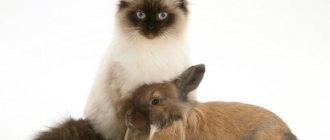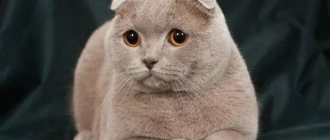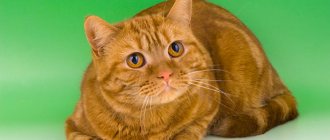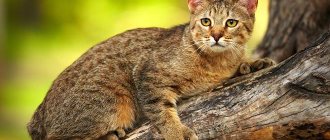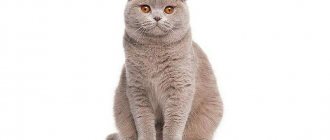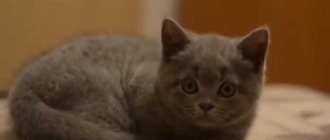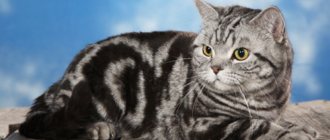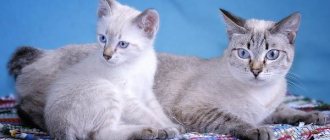British merle color: features of the breed
The first cat show, held in 1879 in London, was attended by the British. Since then, plush animals have gained considerable popularity, as kittens were actively bought by foreign breeders and taken outside the country. The breed, despite its long existence, was officially recognized only in 1950.
At the end of the 70s of the last century, a document was created prohibiting breeding them with any other felines. And in 1980, aristocrats received recognition from the FCA Association.
According to the standard, a purebred individual must have:
- Proportional, strong body with clearly developed muscles, squat and dense.
- Large head with wide-set, medium-sized ears (rounded tips).
- A fold around a short massive neck.
- Big round eyes. The color of the iris is predominantly amber-orange, less common is green and blue. Babies have gray-blue eyes, changing color as they grow older.
- Wide chest.
- Well-defined cheekbones, pronounced cheeks, developed chin and wide nose.
- Thick undercoat.
- The coat is short, dense with hairs of equal length. It feels like plush.
- Neat, strong, rounded paws corresponding to the body type.
- Fleshy, medium-length tail with a rounded tip and a wide base.
The British are distinguished by their long lives, often reaching 15-20 years of age. The weight of an adult animal ranges from 5 to 8 kg; height is not indicated in the standard, but must correspond to a dense constitution.
Classic colors
The breed standard includes 229 color and pattern options. Each of them must meet the requirements for the cat to be called a pedigree cat. Before a kitten receives documents and moves to its owner, a specialist checks it for compliance with the standard. They also examine the color, which is characterized by colors:
- undercoat;
- awn;
- drawing, if present;
- eyes, nose and paw pads.
These indicators are influenced by genetics - the coat colors of parents and distant ancestors. Some of them are dominant, others are recessive. When selecting pairs for mating, color compatibility is taken into account. The classic ones include solid, or solid, solid hair along the entire length of the hair. More details about the professional color coding of British dogs can be found in the table below.
Blue
When people picture a British Shorthair, the image that comes to mind is the classic British Blue cat or kitten with dense bluish fur and amber eyes. This coloring is the epitome of the British Shorthair.
The blue or gray color is the first officially recognized in the breed. It appeared because at the stage of creating the British Shorthair, the blood of Russian Blues was infused. This is an extremely attractive coloration.
To be a true British Blue, a cat must have a coat color ranging from light blue to blue-gray, with no hint of striping or white hair. Babies often have light silver markings, but over time the color evens out. The skin on the nose and paw pads is also dark gray, matching the cat's fur. Cat eyes are bright orange or deep amber in color. Many kittens have brown eyes, which acquire the desired shade by adulthood.
White
Pure white color is recognized - and this is the only case where snowy hairs are allowed on the Briton. To be a show level cat, the white tone must be pure, without any yellowish tint.
Sapphire blue or orange eyes with copper, amber or gold tints are allowed. Britons can have one sapphire blue eye and one amber or gold eye; other combinations are not permitted. The skin is pink.
Black
Black cats have fur that is pure black, without rusty hues or brown spots. A shade of rust is unacceptable; the fur must be charcoal.
In summer, such animals can burn out in the sun if they have access to the street. Black leather on the nose and paw pads (no markings) complements this coloration. The breed's classic orange eye color creates a striking combination with black fur.
Chocolate
British Shorthairs got their chocolate color from crossing with Persians. There is a lot of work behind this to curb the tendency for hair to become longer and restore proper coat texture.
It's a beautiful color, especially when paired with orange eyes. The shade can vary from rich chocolate to dark chocolate.
Lilac
The term “lilac” or “lilac” is used by felinologists to denote a delicate frosty gray, which is lighter than classic blue and has a noticeable pinkish tint. The nose skin and paw pads of the Lilac British Shorthair should be colored like fur.
Red
It assumes a rich red coat color, with as few stripes and markings as possible. Like ginger-haired humans, these cats sometimes have freckles on bare areas such as their pads, nose skin, ears, eyelids and lips. While there are only a few freckles, judges at shows do not fine even adult cats for them.
Cinnamon
Cinnamon - the color of cinnamon - was included in the breed standard recently. Cats with this coloration have a warm reddish-brown color, similar to the spice of the same name. They may have pink or cinnamon noses and paw pads.
Faun
The word "fawn" is used to refer to fawn cats whose fur is a light and warm shade of pink. Their nose skin and paw pads must be yellowish-pink to meet the breed standard. The most common defect is silver spots, which are only acceptable in kittens.
Cream
Cream, or peach, is a color similar to cream: pale white or beige. The skin of your cat's nose and paw pads should be pink.
Cream cats may have several stripes, but they should be as faint as possible. Like red cats, cream cats sometimes have freckles.
Features of color and types of harlequin British
During the First and Second World Wars, the British population was in danger of extinction. To quickly restore the livestock, breeders added fresh blood, crossing English immigrants with Persians, exotics, Russian Blues, Burmese, Scottish Folds, and Chartreuses.
As a result of experiments, the breed was improved, and color variations expanded. Today there are more than 200 species.
Be sure to read:
What food should you feed your adult Scottish Fold cat and kitten?
The most popular are:
- Plain (solid) – basic. These include black, chocolate, cream, blue, red, white, purple.
- Tortoiseshell. This species is characterized by spots of two colors, evenly distributed throughout the coat.
- Particolors. The combination of white with the main color, this group includes harlequins, bicolors, etc.
- Golden - appeared recently, divided into shaded and ticked.
- Smoky – characterized by balayage hair coloring, pigmented only at the ends and not dyed at the root. Available in two versions - chinchilla and smoky.
- Color point - light main fur with dark spots in certain places, was inherited by the British from the infusion of Siamese blood.
- Patterned (tabby) - the standard recognizes the brindle, ticked, marbled, spotted variant.
- Silver – available in ticked and shaded form.
The tabby color to which the marbled variety belongs takes its name from the province of Attabiya (Baghdad, Turkey), famous for the production of striped fabric. It is generally accepted that such wool is the result of the presence of forest cats or Nubian dun cats in the British family.
What does a marbled tabby cat look like?
Breeders have developed a huge number of types of cat colors, in particular tabby, which is characterized by 2, less often 3 colors, and the contrasting shade forms a clear pattern. Tabby can be spotted, brindle, ticked (ticked) and marbled, which is considered classic. The marbled cat has the following characteristics:
- fur on the forehead of a contrasting color, forming the letter M;
- eyes and nose with outline of the main shade;
- alternating rings on the tail and limbs;
- two rows of separated button-like markings on the chest and belly;
- multi-colored stripes around the neck called necklaces;
- three pronounced wide lines along the back;
- a pattern on the shoulders resembling a butterfly;
- circles, semicircles or symmetrical patterns on the sides;
- the eyes are a rich yellow shade.
The patterns on the body of a marbled cat, regardless of breed, should be clear, and the contrast between the main and other colors should be sharp. You can see what the four-legged owner of a marble tabby looks like in the photo.
Character and habits of marbled British
The British are intellectuals, they can determine the owner’s mood by their voice and gestures, and by a person’s elevated tone they quickly realize that they are doing something illegal. Imposing, dignified, calm cats are not prone to aggression, rancor, or mischief, but at the same time they know how to protect their boundaries and will not allow their person to be treated unceremoniously.
They are independent, you should not expect annoying affection, stormy meetings, or lightning-fast appearance at the first call from them. It seems that this cat has “his own person” and patronizes him condescendingly. But behind this external equanimity lies a tender devotion to all family members.
They get along well with other cats and dogs, as long as they don't pester them too much. They do not need constant company; the British can be called the introverts of the cat world.
Caring for the British Marbled's coat
By nature, these cats are clean, they take good care of their fur, actively licking themselves, but to make the fur look perfect, human intervention is essential:
- Grooming is trusted to professionals; without proper experience, it is easy to ruin the appearance of your pet. This breed sheds profusely; grooming will significantly reduce the amount of hair in the house. In the summer, the procedure helps cats not suffer from overheating. The British should not be given sedatives before visiting the hairdresser, but due to their phlegmatic nature, they rarely show resistance.
- To comb, you need to purchase a rubber slicker brush or a comb with rounded teeth. Domesticated individuals shed longer and more heavily than their walking counterparts. You need to scratch your cat every day.
- It is not necessary to bathe this breed often; 2 times a year is enough. Water for bath procedures should be warm, about 30°C, washing products are selected taking into account color. Show cats are bathed more often, up to once every 1-2 months.
Be sure to read:
Kobi cat with beautiful eyes - what kind of breed: truth or fiction, description, character, care
To prevent the appearance of fleas, preventive disinfestation should be carried out (the regularity depends on the duration of the drug specified in the instructions), and special insect-repellent collars should be put on the animal.
How to choose a kitten
You should know that even newly born kittens already have characteristic patterns on their fur. The ornament, however, is often weakly expressed, but always contrasting. Saturation appears within a couple of months. In any case, at the time of sale, all obvious signs of marbling are already present.
Don't trust those who claim that babies always have a uniform color after birth and only then do patterns appear on their coats - most likely, you are simply being scammed.
Otherwise, the selection criteria remain the same as in general cases, that is, kittens should be:
- active;
- curious;
- not shy;
- with dry eyes and a nose without snot;
- beautiful shiny fur.
Features of mating marbled British
Cats in their first heat are not allowed to mate; the body is not yet ready to bear viable offspring. It is optimal to schedule the denouement for the third mating season. A partner should be selected in advance; for breeding, a candidate is sought in the club. It is advisable for a young female to be provided with a partner with experience.
Before this, both of them must be wormed two weeks in order to avoid infection of kittens with helminths during birth. The mark on comprehensive vaccination and rabies injection must be made no earlier than a month before the intended date and no later than a year. A cat's claws must be trimmed before mating.
During mating games, the female often slaps her gentleman in the face with her paw; such a preventive measure will help avoid eye injuries in case of an unsuccessful hit.
The cat is brought to the male, it is advisable to provide her with her own bowl, tray, transportation, where she can retire to rest. Some ladies need time to adapt to new conditions, but after an hour or two, instinct will prevail over caution.
Owners sometimes enter into written agreements on the temporary transfer of the animal into someone else’s hands, which also stipulates the conditions under which mating takes place (free of charge, for money, a maintenance kitten, etc.). The paper eliminates controversial issues in the future. If pregnancy does not occur, the other party should be notified.
Genetics of color inheritance
There are so many colors of British cats that it’s easy to get confused among them. To organize the diversity of the color range, colors are divided into groups according to coat pattern, color and pigmentation. There are two basic colors that are directly involved in the formation of others:
- black;
- red.
Each color is formed due to a special substance - melanin. The pigment is found in cat hair in the form of microscopic granules that vary in shape, size and quantity. Melanin is divided into two chemical subtypes:
- zumelamine (gene B) - spherical granules that absorb light and form a black color (responsible for the black color and its derivatives);
- pheomelamin (gene A) - ellipsoidal granules that reflect light in the red range (producer of all shades of red).
The genes responsible for the offspring being red (O - orange) or black (o - not orange) are located on the X chromosome. The color of the future offspring is directly related to the gender of the parents. Females have two X chromosomes, and males have one, therefore, cats are responsible for three basic colors:
- OO - red;
- oo - black;
- Oo - tortoiseshell (red-black).
Genes located on the X chromosome are passed from mother to children. Accordingly, a red cat will not be able to give birth to black offspring, and a black cat will not produce red kittens. In cats, the color of the offspring depends on which gene is carried on the only chromosome (O or o), the choice is small - red or black. Tortoiseshell cats appear only in cases of pathology and are almost always infertile.
Cats can only be tricolor as a result of mutation.
British black color
The dominant (dense) gene D and its companion, the recessive (diluted) gene d, are responsible for the color intensity. In order for the B gene (zumelamine) to appear and give a coal-black color, the cat must have the saturation gene D. Thus, for the formation of an intensely colored black color, dominant genes B and D must be present in the pet’s body. The recessive gene d dilutes the black color, makes it is washed out and gives lighter shades.
British black cats differ from their counterparts not only in color, but also in the quality of their coat - it is stiffer and has a characteristic, pronounced shine. This is due to the fact that the guard hair of black animals is more densely saturated with pigmentation. The signature plush coat is not typical for black individuals, but this is not considered a disadvantage.
Black British fur coats are denser and less plush.
The Difficulties of Breeding British Marbleds
During pregnancy, which lasts 63 days, the cat should be fed well, but not allowed to overeat. Excess weight puts extra strain on the heart. Females usually give birth on their own. It is advisable for an inexperienced owner to agree in advance with the veterinarian about the possibility of a home visit in the event of an unforeseen complication.
Be sure to read:
British cat: character, care and maintenance, sterilization, when to vaccinate, feeding, what diseases they are susceptible to
Often, when crossing British cats, kittens are born that breeders, out of ignorance or for profit, sell as marbled, although in fact they are moire. It is easy to distinguish one from another. Tabbies are patterned in a color different from the main one, and moire specimens are painted in a darker shade of the “base”; over time they will become monochromatic.
How to get marbled kittens
A recessive gene is responsible for this color, so to get tabby kittens it is necessary to mate parents with the same coat.
A merle litter can be obtained from the mating of a spotted individual with a brindle, two brindles, or a pair of spotted ones if they both carry the recessive gene.
Merle color varieties
Depending on the main color, the following types of marble are distinguished:
- blue merle (blue) - lightening black to gray;
- red merle (red) - lightening red to cream or light brown;
- sable merle (sable) - a combination of sable color and blue merle (immediately after birth, the puppy appears almost white, but darkens as it grows up);
- cryptic merle (hidden) - resembles a tricolor; the presence of the M gene can only be indicated by a tiny silver speck (most often determined only by genetic analysis);
- white merle (double or double) - most of the body is painted white, spots are practically or completely absent.
The last type is the most dangerous. This is what is obtained when mating 2 spotted dogs. It is distinguished from the plain white color by the absence of pigmentation on the skin. Double merle puppies are born with pinkish lips, nose and eyelid rims. While in truly snow-white dogs (for example, Samoyeds), these areas are always painted black.
